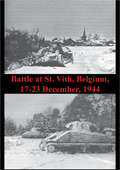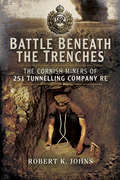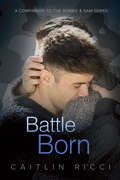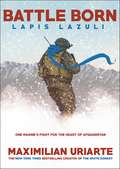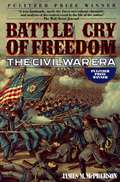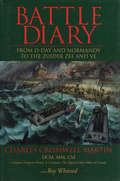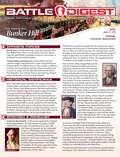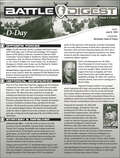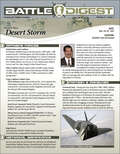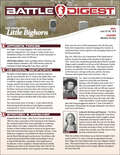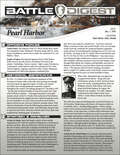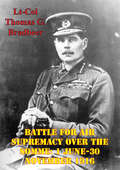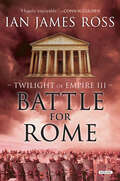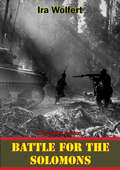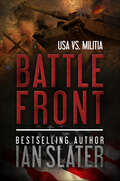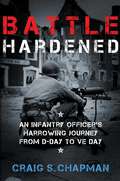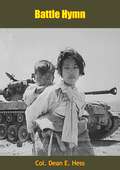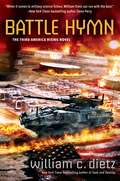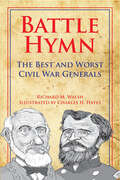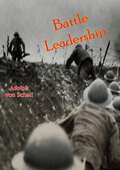- Table View
- List View
Battle At St. Vith, Belgium, 17-23 December, 1944 [Illustrated Edition]
by AnonIncludes 11 excellently detailed mapsThis is the narrative of one phase of the greatest pitched battles on the Western Front in World War II. The battle of St. Vith is an excellent example of how American Troops held their ground in the midst of confusion, defeat, and uncertainty; and thereby threw the German timetable sufficiently off schedule to allow American forces to regroup, hold, and then counterattack. The stand at St. Vith has been recognized by both German and Allied commanders as a turning point in the Battle of the Bulge.
Battle Beneath the Trenches: The Cornish Miners of 251 Tunnelling Company RE
by Robert JohnsUndermining the positions of the enemy is one of the most ancient activities. For almost 3000 years even before 1914, it was a popular siege-breaking technique. During the Great War, arguably the greatest siege the world had ever seen, it presented a conflict environment that perfectly favoured the skills of the military miner. During 1915, the Western Front was established as a static line that grew into a huge network of defence-in-depth earthworks. Siege conditions demanded siege tactics and as the ground was everywhere mineable, the Western Front was a prime candidate for underground warfare.Royal Engineer tunnelling companies were specialist units of the Corps of Royal Engineers within the British Army, formed to dig attacking tunnels under enemy lines during the First World War. The Cornish Miners were one of these specialist units recruited from the tin mines of Cornwall.In February 1915, eight Tunnelling Companies were created and operational in Flanders from March 1915. By mid-1916, the British Army had around 25,000 trained tunnellers, mostly volunteers taken from mining communities. This is their story.
Battle Born (Robbie & Sam)
by Caitlin RicciA Companion to the Robbie & Sam SeriesDaniel Messana wanted a way out of Thornwood, Colorado, and he found it in the Army. Now he’s returned with no more direction to his life than he had when he left as an angry teenager. And even though the war is behind him, the things he experienced won’t leave him in peace. His PTSD plagues him in crowds, and isolation sets in when he’s by himself. Because of the way he treated his brothers, regret gnaws at him, and he has no family to turn to. For Franklin “Coop” Cooper, the Army was life, and one he loved. But when an IED in Afghanistan left him blind, it ended not only the career he’d built, but any chance of being his own man. Back home, his parents refuse to let him do anything for himself, even though Coop and his service dog are ready to move forward and adjust to his new conditions. His only escape from being coddled like a child is going for pizza on base while his mother shops on Fridays. There, Daniel sits down next to him, and the two men begin a friendship that could become more—if they can break free from everything holding them back.
Battle Born: Lapis Lazuli
by Maximilian UriarteFrom the bestselling author of The White Donkey, a heartbreaking and visceral graphic novel set against the stark beauty of Afghanistan's mountain villages that examines prejudice and the military remnants of colonialism.In this hotly anticipatednew work from Maximilian Uriarte, creator of the popular Terminal Lance comics and The White Donkey, tells a "thrillingly cinematic" (Publishers Weekly) story of the personal cost of war and the power of human connection. Lapis Lazuli is a rich blue semiprecious gemstone found deep in the Sar-i-sang mountains of Afghanistan's Badakhshan province. For thousands of years it has sustained the nearby mining villages, whose inhabitants lived peacefully in the mountainous landscape--until the Taliban, known in the region as the Horsemen, came to seek the riches stored deep beneath the earth. Taliban rule has turned the stone into a conflict mineral, as they steal and sell it for their own gain. At the behest of the fledgling Afghan government, seeking to wrest back control of the province, United States Marines are sent into the mountains. A platoon led by their eager and naive commander, First Lieutenant Roberts, and a stoic, fierce squad leader, Sergeant King, must overcome barriers of language and culture in this remote region to win the locals' trust, and their freedom from Taliban rule. Along the way, they must also wrestle with their demons--and face unimaginably difficult choices.A sweeping yet intimate story about brutality, kindness, and the remnants of colonialism, Battle Born: Lapis Lazuli is an epic saga from the voice of a new generation of military veterans.
Battle Command In The Storm: Lieutenant General Franks And VII Corps
by Major John T. RyanThis study examines the concept of battle command from a modem historical perspective. It analyzes the decision making and leadership displayed by Lieutenant General Franks during the planning, preparation and execution of Operation Desert Storm to determine if General Franks exhibited the principles of battle command. Decision making and leadership are the two major components of battle command, a concept championed by Franks following Desert Storm, and, as such serve to frame the discussion. As the commander of the U.S. VII Corps during Operation Desert Storm, General Franks made decisions that had tactical, operational, and strategic implications. These decisions directly affected the lives and actions of the over 142,000 U.S. and British service-members assigned to his command. The results were overwhelmingly successful but many criticized him for being too cautious and conservative. This study investigates if the criticism founded in fact or whether General Franks was merely striking the best balance possible between decision making and leadership on the battlefield.
Battle Cry
by Leon UrisBattle Cry is the riveting Marine epic by the bestselling author of such classics as Trinity and Exodus. Originally published in 1953, Leon Uris's Battle Cry is the raw and exciting story of men at war from a legendary American author. This is the story of enlisted men - Marines - at the beginning of World War II. They are a rough-and-ready tangle of guys from America's cities and farms and reservations. Led by a tough veteran sergeant, these soldiers band together to emerge as part of one of the most elite fighting forces in the world. With staggering realism and detail, we follow them into intense battles - Guadalcanal and Tarawa - and through exceptional moments of camaraderie and bravery. Battle Cry does not extol the glories of war, but proves itself to be one of the greatest war stories of all time.
Battle Cry of Freedom: The Civil War Era
by James M. McphersonThe history of the Civil War that brings to life, the generals, the presidents, the soldiers, politicians, Abolitionists, Southern fire-eaters, Northern barn-burners, Copperheads, and Know-Nothings. A volume on the war and its background<P><P> Pulitzer Prize Winner
Battle Diary: From D-Day and Normandy to the Zuider Zee and VE
by Charles Cromwell Martin Roy WhitsedA fast-paced account by a soldier who was twice decorated. Charlie Martin, company sergeant-major in the Queen’s Own, was with his beloved A Company in all of the significant Normandy actions.
Battle Digest: Bunker Hill
by Christopher J. Petty<p>The Battle Digest summary includes all the key aspects of the campaign and battle, including maps, images, and lessons learned.<p> <p>In the weeks following the skirmishes at Lexington and Concord, Colonial militia and volunteers rallied around Boston to besiege Lt. Gen. Thomas Gage’s British garrison. But when reinforcements arrived from England, Gage devised a plan to regain the initiative by occupying Dorchester Heights south of town. When the Colonials heard of Gage’s plan, however, they preempted him by occupying different high ground ? the heights of Bunker Hill near Charlestown.<p> <p>When Gage awoke on 17 June to the sight of rebel positions on Breed’s Hill, he quickly attacked in what would be the first pitched battle of the American Revolution. The misnamed Battle of Bunker Hill would prove a costly and shocking victory for the British, while giving the Colonials faith in their militias and an important boost of confidence for the long struggle ahead.<p>
Battle Digest: D-Day (Battle Digest Series)
by Flint Whitlock Christopher J. Petty<p>A concise guide to the Normandy invasion with facts, maps, historical significance, strategies, and more.<p> <p>Operation Overlord, commonly referred to as “D-Day,” was the Allied invasion to secure a foothold in northern France to enable the final offensive into Germany. The Normandy invasion would be the largest combined air-sea assault landing in history. This massive feat would finally enable the Allies to deploy forces on the continent, of sufficient size and scale, to bring about the beginning of the end of Hitler and his Third Reich.<p> <p>Learn how General Eisenhower managed to attack German weakness with Allied strength as well as how intelligence and deception were crucial to the outcome.<p> <p>The Battle Digest summary includes all the key aspects of the campaign and battle, including maps, images, and lessons learned.<p>
Battle Digest: Desert Storm (Battle Digest Series)
by Christopher J. Petty<p>A concise guide to the American-led coalition’s speedy defeat of Saddam Hussein in 1991, with maps, facts, historical significance, and more. Just two years after the end of Iraq’s war with Iran, an emboldened Iraqi dictator, Saddam Hussein, invaded Kuwait. Operation Desert Storm was the final phase of the U.S.-led Coalition’s effort to expel Saddam’s forces from his southern neighbor’s borders. In less than 100 hours of joint air and ground combat, the U.S. and its allies would not only triumph, but also demonstrate to the world the superiority of a new breed of weapons. The battle also had the unintended effect of renewing a pride and confidence in the U.S. military after the long shadow of Vietnam.<p> <p>Learn how America built a coalition of nations to go to war, and how Gen. Norman Schwarzkopf used maneuver and deception to create one of the most lopsided victories in the history of warfare.<p> <p>The Battle Digest summary includes all the key aspects of the campaign and battle, including maps, images, and lessons learned.<p>
Battle Digest: Little Bighorn (Battle Digest Series)
by Michael E. Haskew Christopher J. Petty<p>A concise history of Custer’s Last Stand with maps, facts, historical significance, and more. The battle of Little Bighorn, despite its relatively small size, was the worst defeat for the U.S. Army in the Indian Wars. Although it was a clear tactical victory for the Plains Indians, it also would be a significant strategic setback for their cause. The outrage resulting from the Indian victory only intensified efforts by the U.S. Army and its Department of the Missouri to pacify the Native Americans and return those who resisted to their reservations. Within months of their victory at the Little Bighorn, the Plains Indians were defeated in the Great Sioux War of 1876–1877 and their lands in the Black Hills of the Dakota Territory were confiscated.<p> <p>Learn why the controversial George A. Custer rushed into battle against his Indian opponents on that fateful day, and how Brigadier General Terry’s failure to synchronize his forces contributed to “Custer’s Last Stand.”<p> <p>The Battle Digest summary includes all the key aspects of the campaign and battle, including maps, images, and lessons learned.<p>
Battle Digest: Pearl Harbor (Battle Digest Series)
by Michael E. Haskew Christopher J. Petty<p>A concise guide to the Japanese attack on Hawaii that plunged America into WWII, with facts, maps, historical significance, and more.<p> <p>As America prepared for WWII, everything changed on December 7, 1941—described by President Franklin D. Roosevelt as a “date which will live in infamy”—when Japan launched a successful surprise attack on the U.S. Pacific Fleet anchored at Pearl Harbor. The devastating attack crippled the fleet, while showing the world the new dominance of carrier-borne aircraft in naval warfare. Japan’s tactical success, however, belied her strategic failure. With America’s declaration of war the following day, Japan had created a determined and powerful enemy. And while Japan did gain time to expand in the Pacific, that time would be short-lived. Japan had awakened the “sleeping giant” of America.<p> <p>Learn how Admiral Yamamoto’s bold plan caught America by surprise yet doomed the larger Japanese cause. Learn also about Japan’s lost opportunities during the attack—opportunities that would have tilted the scales decidedly more in her favor.<p> <p>The Battle Digest summary includes all the key aspects of the campaign and battle, including maps, images, and lessons learned.<p>
Battle Digest: Shiloh (Battle Digest Series)
by Michael E. Haskew Christopher J. PettyThe Battle Digest summary includes all the key aspects of the campaign and battle, including maps, images, and lessons learned. After his early success in the Civil War’s Western Theater, Maj. Gen. Ulysses S. Grant moved south to capture the key railroad hub at Corinth and further cut into the Confederate hold on the Tennessee and Mississippi River Valleys. But Confederate Gen. Albert S. Johnston wasn’t playing by Grant’s script. Instead of waiting for Grant to combine armies with Maj. Gen. Don Carlos Buell, Johnston moved north for a surprise attack. It almost worked. But after taking a beating the first day, a resolute Grant rallied his army and pushed the Confederates back, salvaging victory from what appeared to be certain defeat and further opening the Confederacy’s vulnerable Western flank. But Shiloh was also a sobering wake-up call for both sides. With carnage on a scale not seen before, all illusions of a short and low-cost war were shattered.
Battle For Air Supremacy Over The Somme: 1 June-30 November 1916
by Lt-Col Thomas G. BradbeerMuch has been written about the Battle of the Somme. From July through late November 1916, British, French, and German armies fought one of the costliest battles of the twentieth century. Well over a million casualties and only a few miles of ground gained by the Allies were the result when the battle ended. Little, however, has been written about the second battle which occurred simultaneously, this one in the skies above the Somme, where for the first time in the history of warfare a deliberate attempt was made to control the sky. The British Royal Flying Corps, under the resolute command of General Sir Hugh Trenchard, fought to gain air supremacy from the German Air Service. Trenchard believed that the best way to support the ground force was to dominate and control the sky above the battlefield. This air campaign was critical because of its impact on the doctrine and theory of air warfare which followed it.This study examines the efforts of the Royal Flying Corps to gain air supremacy against the German Air Service before and during the Battle of the Somme.
Battle For Rome: Twilight of Empire III (Twilight of Empire #3)
by Ian James RossIn this &“well-crafted, atmospheric&” war novel set in ancient Rome, an officer battles under Constantine while in the midst of personal turmoil.(Ben Kane, author of Fields of Blood) The Roman Empire is on the brink of civil war. Only Maxentius, tyrant of Rome, stands between the emperor Constantine and supreme power in the west. Aurelius Castus is now a tribune in Constantine's army. But great honor brings new challenges: Castus is tormented by suspicions that his young wife has been unfaithful. And as Constantine becomes increasingly devoted to Christianity, he is forced to ask himself whether he is backing the wrong man. The coming war will decide the fate of empire. But Castus's own battle will carry him much further. &“Hugely enjoyable. The author winds up tension into an explosion of fast-paced events.&” —Conn Iggulden, author of Stormbird &”A thumping good read . . . thoroughly enjoyable.&” —Ben Kane, author of Lionheart &“This is up there with Harry Sidebottom and Ben Kane.&” —M.C. Scott, author of Into the Fire
Battle For The Solomons [Illustrated Edition]
by Ira WolfertIncludes the Island War In The Pacific Illustration Pack - 152 maps, plans and photos.Pulitzer Prize winning author Ira Wolfert provides a gripping eye-witness account of one of the pivotal campaigns of the Second World War.The campaign to liberate the Solomon islands from Japanese domination, which had crept sloe to cutting off Australia and New Zealand, was hugely important in regaining the initiative for the Allies in the Pacific. The action in this account is centered around the legendary fighting on Guadalcanal, in the air, on the sea and on the land. The author toured the area recording the thoughts, feelings and anecdotes of the American Marines, Soldiers, Sailors and Airmen who fought this brutal but successful campaign. Weaving all of these parts into a narrative of vivid clarity he captured the spirit of the "Greatest Generation" as they faced their most implacable enemy, the forces of Imperial Japan.
Battle Front (USA vs. Militia)
by Ian SlaterThe final collapse of trust between the ruled and the rulers has happened in an America where civil war rages again. From bestselling author Ian Slater. "As impelling a storyteller as you're likely to encounter."—Clive Cussler The Federals drew first blood as battalions of freedom fighters went tank-to-tank with the National Guard in the Northwest. Though the President declares the area secure, top officials know the truth: The Militia movement is spreading from the fringes like wildfire, now more organized, committed, and violent than ever, and hellbent on an armed victory over the United States. No matter how desperately the government tries to regain its hold, the roads of America are shuddering under the columns of tanks, the skies throbbing with Blackhawks. Two hundred thousand trained militiamen are armed with high-tech killing tools and the courage of true believers. And after a spark ignites the Everglades, the USA takes the most explosive hit of all.
Battle Group!: German Kamfgruppen Action in World War Two
by James LucasThe author of War on the Eastern Front offers an in-depth analysis of Nazi Germany&’s shock troop tactics in every theater of WWII. The German army in the Second World War sought to fight and win swift, decisive victories in a succession of short campaigns known as blitzkrieg, or &“lightning war.&” Flexibility was as essential as the will to win. Battle groups, or shock troops, were created from miscellaneous and often disparate military units to undertake a specific local operation; it was the army's skill in combining superior numbers, aggressive tactics and the battle group commander's ability to exploit the changing situation on the ground which brought success on the battlefield. The actions described here cover all theaters of the war, and include battle groups large and small, deployed usually to smash a breach in the enemy line or seal off an enemy penetration. It covers operations in the first dynamic years when Wehrmacht forces defeated the armies of one European country after another in fast campaigns, through to the years after Stalingrad and Africa as they moved towards defeat. The battle groups&’ contribution to Wehrmacht fortunes offer powerful lessons in the tactics of battle management, and this book by James Lucas, a military historian known for his close studies of the German soldier, is considered to be one of the most detailed and authoritative accounts on the subject.
Battle Hardened: An Infantry Officer's Harrowing Journey from D-Day to V-E Day
by Craig S. ChapmanBattle-Hardened: An Infantry Officer's Harrowing Journey from D-Day to VE-Day tells the story of an American soldier's growth from a 2nd Lieutenant eager to prove his worth in battle to a skilled and resolute commander over the course of the Northern European Campaign. Craig Chapman delves deep into the personal recollections and mental state of Bill Champman as he fought against the Nazis, enduring frontline combat and witnessing horror on a massive scale. Lieutenant Chapman maintains his sanity by isolating his emotions from the chaos of the battlefield, and the young officer turns into a hard-edged warrior who dispassionately orders men to risk their lives yet still manages to hold onto his humanity.
Battle Hymn
by Col. Dean E. HessThe explosive, true story of a man of God turned fighter pilot who fought and prayed his way through 300 combat missions and two wars.Author Dean E. Hess is the subject of this inspiring autobiography, Battle Hymn, first published in 1956, which tells of his experiences as a U.S. Air Force colonel, including his involvement in the so-called “Kiddy Car Airlift” during the Korean War on December 20, 1950.With the airfield over capacity, Hess sent Korean orphans to an orphanage in Seoul. When the North Korean forces began to capture the city, Hess reportedly organized 15 C-54 Skymaster aircraft to airlift 950 orphans and 80 orphanage staff from the path of the Chinese advance to safety on Jeju Island. When Hess departed Korea in June 1951, a new orphanage on this island held over 1,000 Korean children.The book later served the basis for the 1957 film of the same name, where he was played by Rock Hudson.“Stirring”—San Francisco Chronicle“In his career as a war correspondent Quentin Reynolds has met his share of heroes, but few of them, he says have impressed him as deeply as Col. Dean E. Hess.”—Readers Digest“Twentieth century American soldiers, sailors, airmen and Marines have enjoyed a warm reputation for caring about the children of the lands they have fought in. Col. Dean E. Hess—Air Force humanitarians—well represents this tradition.”—The Times Magazine
Battle Hymn
by William C. DietzFrom the New York Times bestselling author of the Legion of the Damned® novels comes the final volume in the postapocalyptic military science fiction trilogy about America warring with itself and the people trying to keep it together...The Second Civil War continues to rage as Union president Samuel T. Sloan battles to keep America whole and, more than that, to restore the country to its former greatness."Wanted Dead or Alive." Following a fateful battle between Union Army major Robin "Mac" Macintyre and her sister, the New Confederacy places a price on Mac's head, and bounty hunters are on her trail.But there's work to be done, and Mac is determined to help Sloan reunify the country by freeing hundreds of Union POWs from appalling conditions in Mexico and capturing a strategic oil reserve that lies deep inside Confederate territory.However, to truly have peace it will be necessary to capture or kill the New Confederacy's leadership, and that includes Mac's father, General Bo Macintyre.
Battle Hymn: The Best and Worst Civil War Generals
by Richard M. WalshAn entertaining, informative, and unbiased look at the American Civil War&’s best and worst military leaders. Want to know which general was the most respected by soldiers on both sides? Or why George Thomas is considered the best combat general of the war? Read history professor Richard M. Walsh&’s entertaining book! In it, he reveals the strengths and weaknesses of the Civil War&’s top generals. Find out why Nathan Bedford Forrest and William T. Sherman are both hated and respected. Discover why Stonewall Jackson was considered the best combat leader in the Confederacy and why George McClellan was called &“Little Napoleon.&” Walsh even includes citizen soldiers Patrick Cleburne and Joshua Lawrence Chamberlain in his chronicle. Satirical portraits scattered throughout add to the fun of this educational read.
Battle Leadership
by Adolph Von SchellBattle Leadership by Adolph von Schell is a timeless and insightful examination of the psychological and practical aspects of leadership in combat. Von Schell offers a profound exploration of the challenges faced by leaders on the battlefield and the strategies necessary to inspire and maintain the morale of troops under the most extreme conditions.In this concise yet impactful work, von Schell emphasizes the importance of understanding the human element in warfare. He argues that beyond tactics and strategy, effective leadership in battle requires a deep awareness of the psychological pressures faced by soldiers, including fear, stress, and the uncertainty of combat. Von Schell shares practical advice on how leaders can build trust, communicate effectively, and make quick decisions that instill confidence in their men, even in the chaos of battle.Battle Leadership is rich with anecdotes and lessons learned from the front lines, offering readers a rare glimpse into the mindset of a combat leader. Von Schell’s reflections are grounded in real-world experience, making his insights both credible and relatable for military professionals and anyone interested in leadership under pressure.The book also delves into the dynamics of small unit leadership, highlighting the critical role of junior officers and non-commissioned officers in maintaining the cohesion and effectiveness of their units. Von Schell’s observations on the importance of adaptability, initiative, and the moral responsibilities of leadership remain highly relevant to military leaders today.Battle Leadership is essential reading for military officers, historians, and students of leadership. Adolph von Schell’s wisdom transcends time and context, offering valuable guidance for anyone tasked with leading others in difficult and demanding situations. This classic work continues to inspire and educate new generations of leaders, reinforcing the enduring principles of courage, decisiveness, and empathy in the art of command.
Battle Leadership: Some Personal Experiences of a Junior Officer of the German Army with Observations on Battle Tactics and the Psychological Reactions of Troops in Campaign
by Adolf Von SchellA collection of lessons learned by Adolf von Schell, a small unit infantry commander during World War I.
